Analysis of My Health Record System: Problems, Capabilities, Benefits
VerifiedAdded on 2021/04/19
|8
|1392
|360
Report
AI Summary
This report presents a system analysis of the "My Health Record" project, an electronic health record system designed to enhance patient care and reduce hospital admissions. The report begins with an introduction highlighting the project's goals and objectives. It then identifies problems associated with existing healthcare systems, such as difficulties in providing adequate care in rural areas and the inefficiencies of manual record-keeping. The report proposes the "My Health Record" system as a digital solution to these challenges, offering capabilities such as secure electronic health record storage, comprehensive patient health summaries, and 24/7 access to medical information. Furthermore, the report outlines the benefits of the system, including improved patient health, increased efficiency for healthcare providers, better information sharing, and enhanced patient-physician communication. The conclusion emphasizes the potential of the "My Health Record" system to improve patient care and reduce hospital admissions, supported by the analysis of the project's vision document and relevant references.

Running head: SYSTEM ANALYSIS
System Analysis
Name of the Student
Name of the University
Author Note
System Analysis
Name of the Student
Name of the University
Author Note
Paraphrase This Document
Need a fresh take? Get an instant paraphrase of this document with our AI Paraphraser
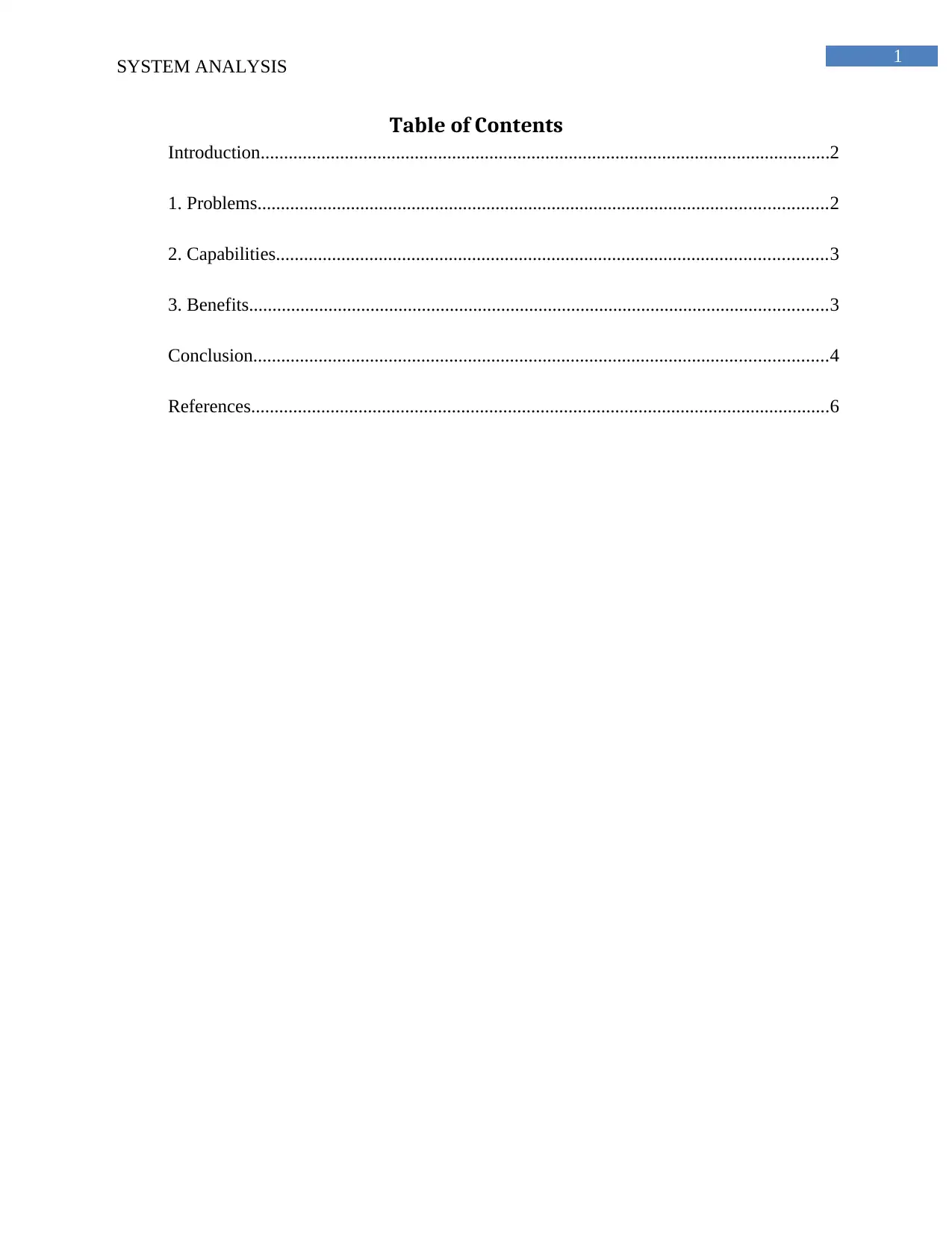
1
SYSTEM ANALYSIS
Table of Contents
Introduction..........................................................................................................................2
1. Problems..........................................................................................................................2
2. Capabilities......................................................................................................................3
3. Benefits............................................................................................................................3
Conclusion...........................................................................................................................4
References............................................................................................................................6
SYSTEM ANALYSIS
Table of Contents
Introduction..........................................................................................................................2
1. Problems..........................................................................................................................2
2. Capabilities......................................................................................................................3
3. Benefits............................................................................................................................3
Conclusion...........................................................................................................................4
References............................................................................................................................6
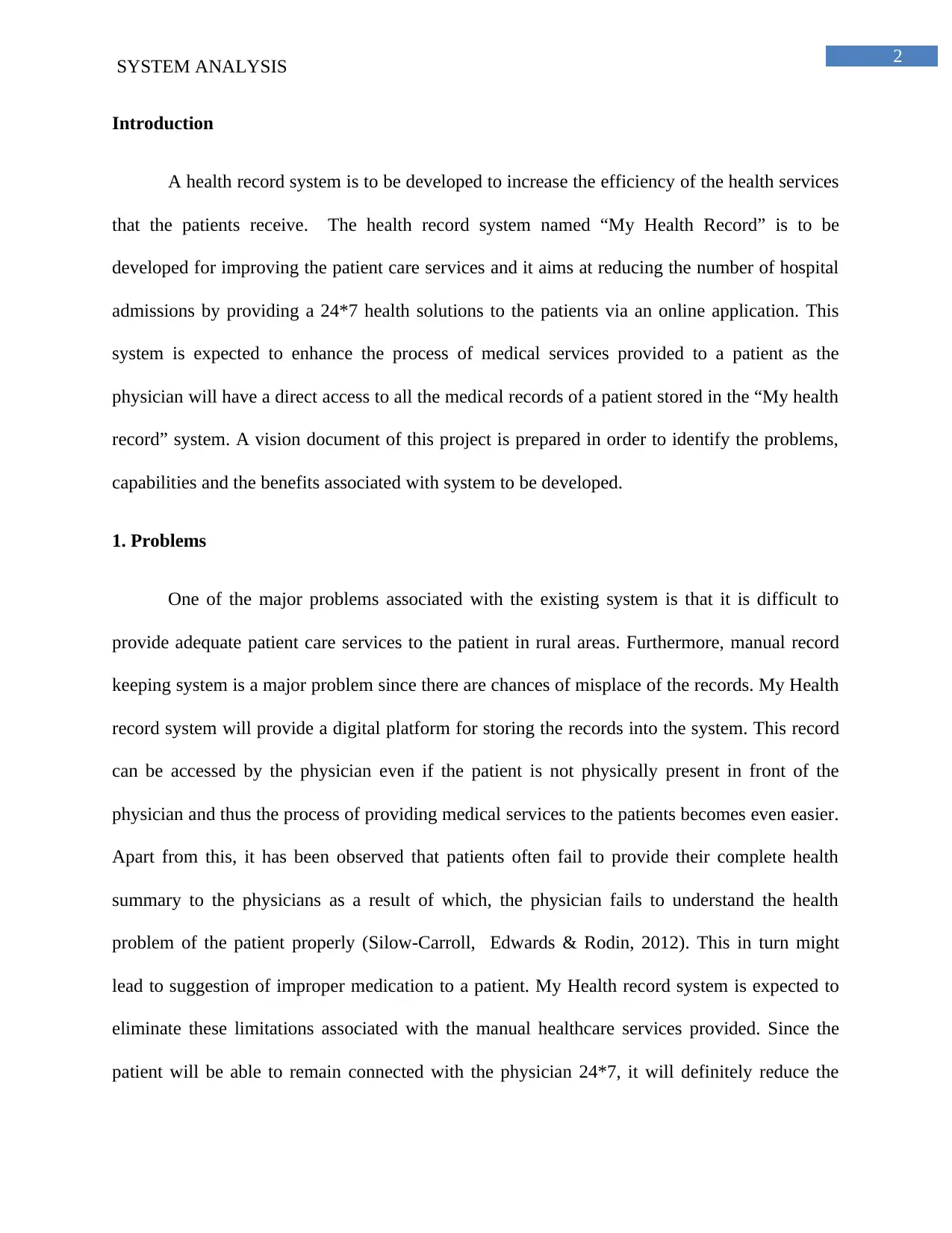
2
SYSTEM ANALYSIS
Introduction
A health record system is to be developed to increase the efficiency of the health services
that the patients receive. The health record system named “My Health Record” is to be
developed for improving the patient care services and it aims at reducing the number of hospital
admissions by providing a 24*7 health solutions to the patients via an online application. This
system is expected to enhance the process of medical services provided to a patient as the
physician will have a direct access to all the medical records of a patient stored in the “My health
record” system. A vision document of this project is prepared in order to identify the problems,
capabilities and the benefits associated with system to be developed.
1. Problems
One of the major problems associated with the existing system is that it is difficult to
provide adequate patient care services to the patient in rural areas. Furthermore, manual record
keeping system is a major problem since there are chances of misplace of the records. My Health
record system will provide a digital platform for storing the records into the system. This record
can be accessed by the physician even if the patient is not physically present in front of the
physician and thus the process of providing medical services to the patients becomes even easier.
Apart from this, it has been observed that patients often fail to provide their complete health
summary to the physicians as a result of which, the physician fails to understand the health
problem of the patient properly (Silow-Carroll, Edwards & Rodin, 2012). This in turn might
lead to suggestion of improper medication to a patient. My Health record system is expected to
eliminate these limitations associated with the manual healthcare services provided. Since the
patient will be able to remain connected with the physician 24*7, it will definitely reduce the
SYSTEM ANALYSIS
Introduction
A health record system is to be developed to increase the efficiency of the health services
that the patients receive. The health record system named “My Health Record” is to be
developed for improving the patient care services and it aims at reducing the number of hospital
admissions by providing a 24*7 health solutions to the patients via an online application. This
system is expected to enhance the process of medical services provided to a patient as the
physician will have a direct access to all the medical records of a patient stored in the “My health
record” system. A vision document of this project is prepared in order to identify the problems,
capabilities and the benefits associated with system to be developed.
1. Problems
One of the major problems associated with the existing system is that it is difficult to
provide adequate patient care services to the patient in rural areas. Furthermore, manual record
keeping system is a major problem since there are chances of misplace of the records. My Health
record system will provide a digital platform for storing the records into the system. This record
can be accessed by the physician even if the patient is not physically present in front of the
physician and thus the process of providing medical services to the patients becomes even easier.
Apart from this, it has been observed that patients often fail to provide their complete health
summary to the physicians as a result of which, the physician fails to understand the health
problem of the patient properly (Silow-Carroll, Edwards & Rodin, 2012). This in turn might
lead to suggestion of improper medication to a patient. My Health record system is expected to
eliminate these limitations associated with the manual healthcare services provided. Since the
patient will be able to remain connected with the physician 24*7, it will definitely reduce the
⊘ This is a preview!⊘
Do you want full access?
Subscribe today to unlock all pages.

Trusted by 1+ million students worldwide
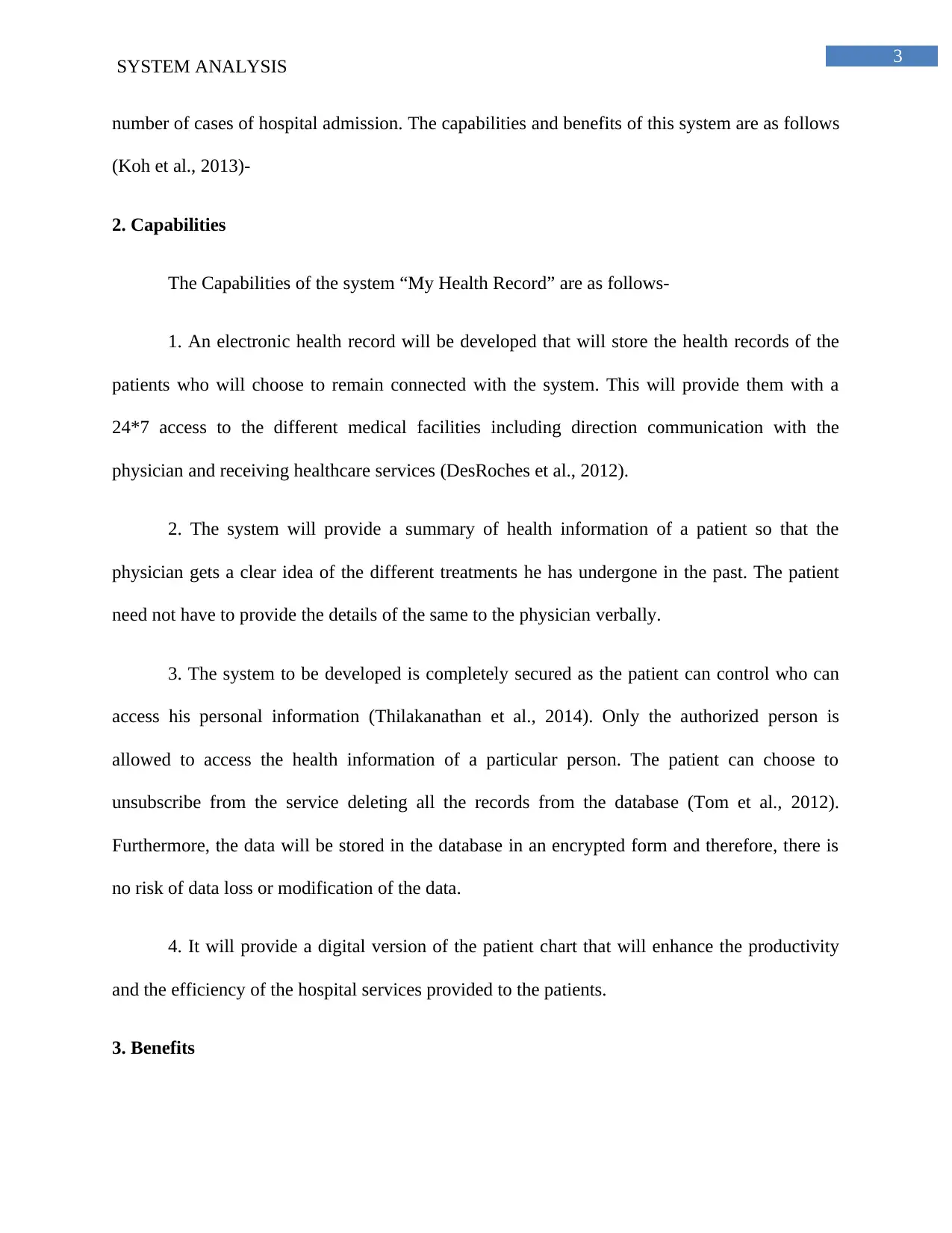
3
SYSTEM ANALYSIS
number of cases of hospital admission. The capabilities and benefits of this system are as follows
(Koh et al., 2013)-
2. Capabilities
The Capabilities of the system “My Health Record” are as follows-
1. An electronic health record will be developed that will store the health records of the
patients who will choose to remain connected with the system. This will provide them with a
24*7 access to the different medical facilities including direction communication with the
physician and receiving healthcare services (DesRoches et al., 2012).
2. The system will provide a summary of health information of a patient so that the
physician gets a clear idea of the different treatments he has undergone in the past. The patient
need not have to provide the details of the same to the physician verbally.
3. The system to be developed is completely secured as the patient can control who can
access his personal information (Thilakanathan et al., 2014). Only the authorized person is
allowed to access the health information of a particular person. The patient can choose to
unsubscribe from the service deleting all the records from the database (Tom et al., 2012).
Furthermore, the data will be stored in the database in an encrypted form and therefore, there is
no risk of data loss or modification of the data.
4. It will provide a digital version of the patient chart that will enhance the productivity
and the efficiency of the hospital services provided to the patients.
3. Benefits
SYSTEM ANALYSIS
number of cases of hospital admission. The capabilities and benefits of this system are as follows
(Koh et al., 2013)-
2. Capabilities
The Capabilities of the system “My Health Record” are as follows-
1. An electronic health record will be developed that will store the health records of the
patients who will choose to remain connected with the system. This will provide them with a
24*7 access to the different medical facilities including direction communication with the
physician and receiving healthcare services (DesRoches et al., 2012).
2. The system will provide a summary of health information of a patient so that the
physician gets a clear idea of the different treatments he has undergone in the past. The patient
need not have to provide the details of the same to the physician verbally.
3. The system to be developed is completely secured as the patient can control who can
access his personal information (Thilakanathan et al., 2014). Only the authorized person is
allowed to access the health information of a particular person. The patient can choose to
unsubscribe from the service deleting all the records from the database (Tom et al., 2012).
Furthermore, the data will be stored in the database in an encrypted form and therefore, there is
no risk of data loss or modification of the data.
4. It will provide a digital version of the patient chart that will enhance the productivity
and the efficiency of the hospital services provided to the patients.
3. Benefits
Paraphrase This Document
Need a fresh take? Get an instant paraphrase of this document with our AI Paraphraser
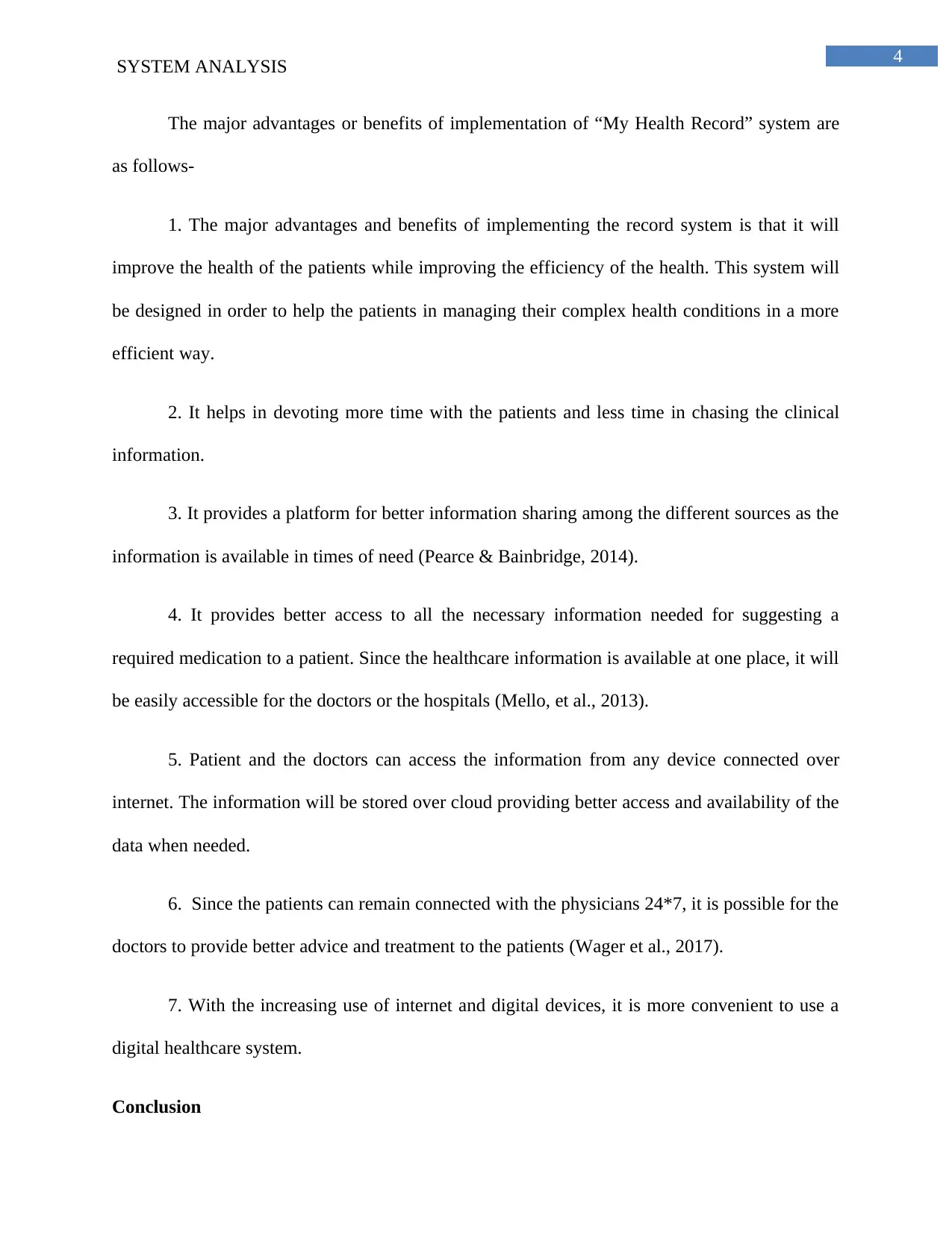
4
SYSTEM ANALYSIS
The major advantages or benefits of implementation of “My Health Record” system are
as follows-
1. The major advantages and benefits of implementing the record system is that it will
improve the health of the patients while improving the efficiency of the health. This system will
be designed in order to help the patients in managing their complex health conditions in a more
efficient way.
2. It helps in devoting more time with the patients and less time in chasing the clinical
information.
3. It provides a platform for better information sharing among the different sources as the
information is available in times of need (Pearce & Bainbridge, 2014).
4. It provides better access to all the necessary information needed for suggesting a
required medication to a patient. Since the healthcare information is available at one place, it will
be easily accessible for the doctors or the hospitals (Mello, et al., 2013).
5. Patient and the doctors can access the information from any device connected over
internet. The information will be stored over cloud providing better access and availability of the
data when needed.
6. Since the patients can remain connected with the physicians 24*7, it is possible for the
doctors to provide better advice and treatment to the patients (Wager et al., 2017).
7. With the increasing use of internet and digital devices, it is more convenient to use a
digital healthcare system.
Conclusion
SYSTEM ANALYSIS
The major advantages or benefits of implementation of “My Health Record” system are
as follows-
1. The major advantages and benefits of implementing the record system is that it will
improve the health of the patients while improving the efficiency of the health. This system will
be designed in order to help the patients in managing their complex health conditions in a more
efficient way.
2. It helps in devoting more time with the patients and less time in chasing the clinical
information.
3. It provides a platform for better information sharing among the different sources as the
information is available in times of need (Pearce & Bainbridge, 2014).
4. It provides better access to all the necessary information needed for suggesting a
required medication to a patient. Since the healthcare information is available at one place, it will
be easily accessible for the doctors or the hospitals (Mello, et al., 2013).
5. Patient and the doctors can access the information from any device connected over
internet. The information will be stored over cloud providing better access and availability of the
data when needed.
6. Since the patients can remain connected with the physicians 24*7, it is possible for the
doctors to provide better advice and treatment to the patients (Wager et al., 2017).
7. With the increasing use of internet and digital devices, it is more convenient to use a
digital healthcare system.
Conclusion
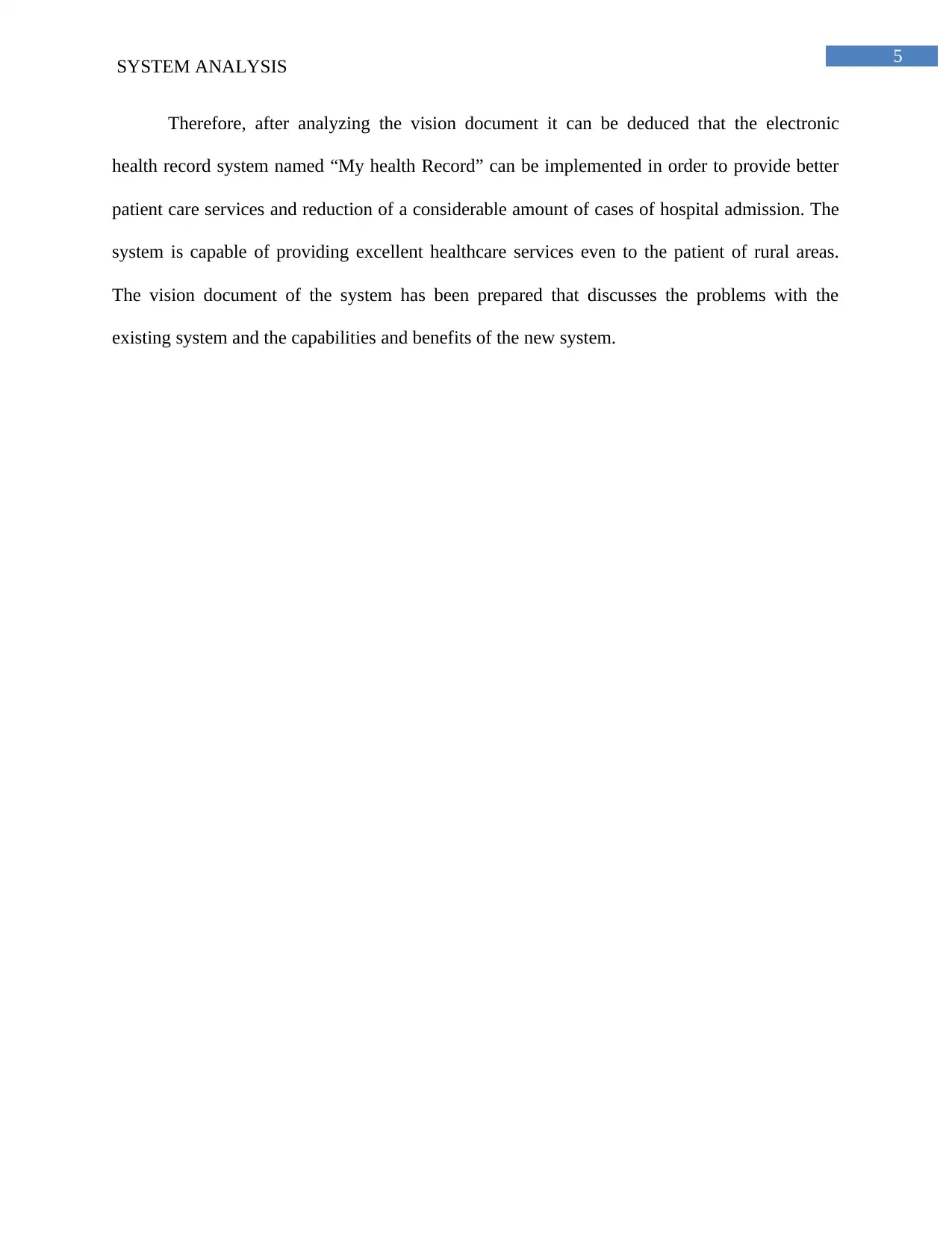
5
SYSTEM ANALYSIS
Therefore, after analyzing the vision document it can be deduced that the electronic
health record system named “My health Record” can be implemented in order to provide better
patient care services and reduction of a considerable amount of cases of hospital admission. The
system is capable of providing excellent healthcare services even to the patient of rural areas.
The vision document of the system has been prepared that discusses the problems with the
existing system and the capabilities and benefits of the new system.
SYSTEM ANALYSIS
Therefore, after analyzing the vision document it can be deduced that the electronic
health record system named “My health Record” can be implemented in order to provide better
patient care services and reduction of a considerable amount of cases of hospital admission. The
system is capable of providing excellent healthcare services even to the patient of rural areas.
The vision document of the system has been prepared that discusses the problems with the
existing system and the capabilities and benefits of the new system.
⊘ This is a preview!⊘
Do you want full access?
Subscribe today to unlock all pages.

Trusted by 1+ million students worldwide
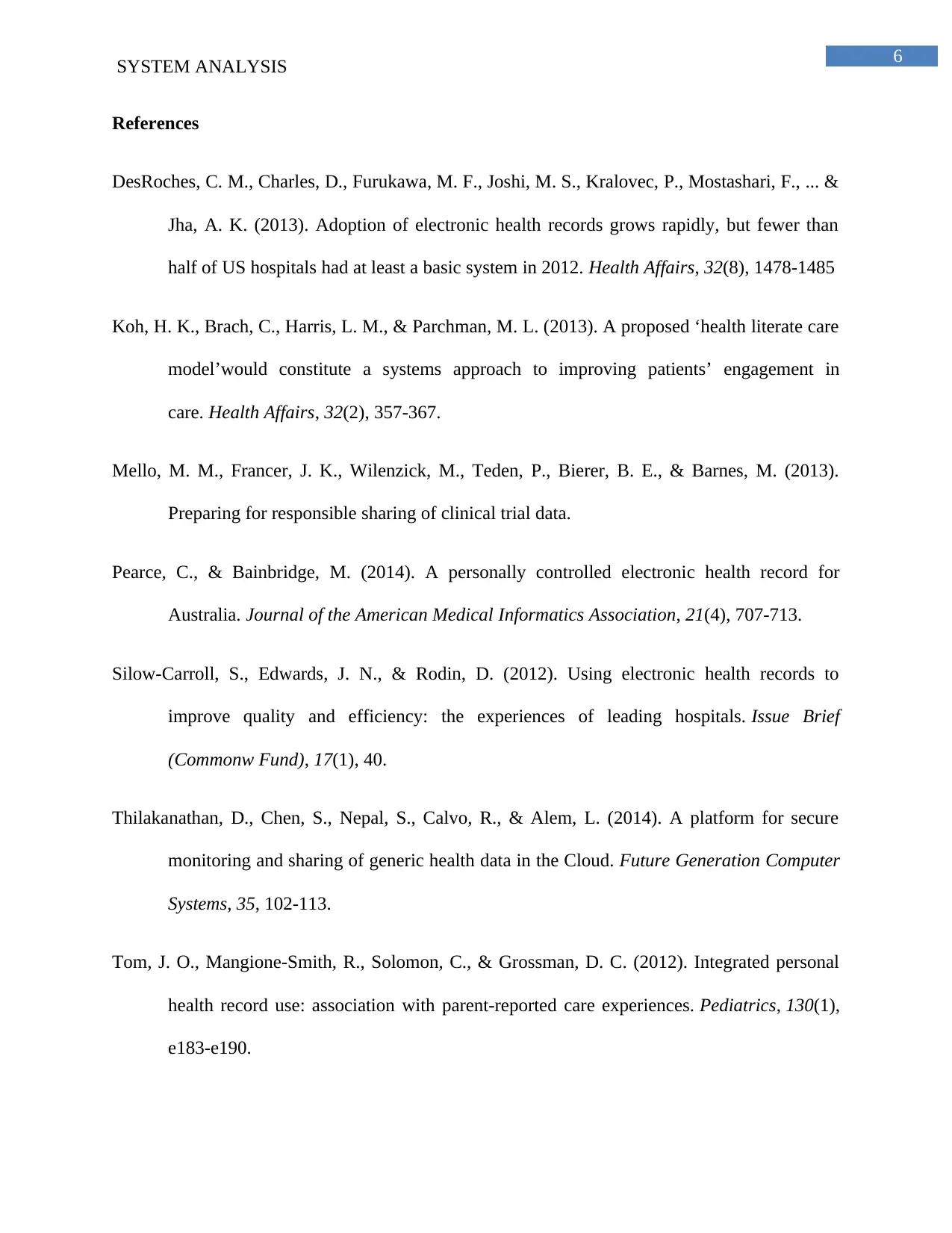
6
SYSTEM ANALYSIS
References
DesRoches, C. M., Charles, D., Furukawa, M. F., Joshi, M. S., Kralovec, P., Mostashari, F., ... &
Jha, A. K. (2013). Adoption of electronic health records grows rapidly, but fewer than
half of US hospitals had at least a basic system in 2012. Health Affairs, 32(8), 1478-1485
Koh, H. K., Brach, C., Harris, L. M., & Parchman, M. L. (2013). A proposed ‘health literate care
model’would constitute a systems approach to improving patients’ engagement in
care. Health Affairs, 32(2), 357-367.
Mello, M. M., Francer, J. K., Wilenzick, M., Teden, P., Bierer, B. E., & Barnes, M. (2013).
Preparing for responsible sharing of clinical trial data.
Pearce, C., & Bainbridge, M. (2014). A personally controlled electronic health record for
Australia. Journal of the American Medical Informatics Association, 21(4), 707-713.
Silow-Carroll, S., Edwards, J. N., & Rodin, D. (2012). Using electronic health records to
improve quality and efficiency: the experiences of leading hospitals. Issue Brief
(Commonw Fund), 17(1), 40.
Thilakanathan, D., Chen, S., Nepal, S., Calvo, R., & Alem, L. (2014). A platform for secure
monitoring and sharing of generic health data in the Cloud. Future Generation Computer
Systems, 35, 102-113.
Tom, J. O., Mangione-Smith, R., Solomon, C., & Grossman, D. C. (2012). Integrated personal
health record use: association with parent-reported care experiences. Pediatrics, 130(1),
e183-e190.
SYSTEM ANALYSIS
References
DesRoches, C. M., Charles, D., Furukawa, M. F., Joshi, M. S., Kralovec, P., Mostashari, F., ... &
Jha, A. K. (2013). Adoption of electronic health records grows rapidly, but fewer than
half of US hospitals had at least a basic system in 2012. Health Affairs, 32(8), 1478-1485
Koh, H. K., Brach, C., Harris, L. M., & Parchman, M. L. (2013). A proposed ‘health literate care
model’would constitute a systems approach to improving patients’ engagement in
care. Health Affairs, 32(2), 357-367.
Mello, M. M., Francer, J. K., Wilenzick, M., Teden, P., Bierer, B. E., & Barnes, M. (2013).
Preparing for responsible sharing of clinical trial data.
Pearce, C., & Bainbridge, M. (2014). A personally controlled electronic health record for
Australia. Journal of the American Medical Informatics Association, 21(4), 707-713.
Silow-Carroll, S., Edwards, J. N., & Rodin, D. (2012). Using electronic health records to
improve quality and efficiency: the experiences of leading hospitals. Issue Brief
(Commonw Fund), 17(1), 40.
Thilakanathan, D., Chen, S., Nepal, S., Calvo, R., & Alem, L. (2014). A platform for secure
monitoring and sharing of generic health data in the Cloud. Future Generation Computer
Systems, 35, 102-113.
Tom, J. O., Mangione-Smith, R., Solomon, C., & Grossman, D. C. (2012). Integrated personal
health record use: association with parent-reported care experiences. Pediatrics, 130(1),
e183-e190.
Paraphrase This Document
Need a fresh take? Get an instant paraphrase of this document with our AI Paraphraser

7
SYSTEM ANALYSIS
Wager, K. A., Lee, F. W., & Glaser, J. P. (2017). Health care information systems: a practical
approach for health care management. John Wiley & Sons.
SYSTEM ANALYSIS
Wager, K. A., Lee, F. W., & Glaser, J. P. (2017). Health care information systems: a practical
approach for health care management. John Wiley & Sons.
1 out of 8
Related Documents
Your All-in-One AI-Powered Toolkit for Academic Success.
+13062052269
info@desklib.com
Available 24*7 on WhatsApp / Email
![[object Object]](/_next/static/media/star-bottom.7253800d.svg)
Unlock your academic potential
Copyright © 2020–2025 A2Z Services. All Rights Reserved. Developed and managed by ZUCOL.





